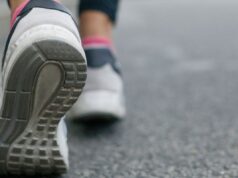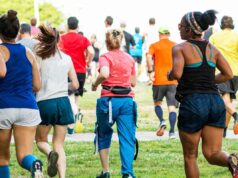Posture & Performance
We all want to run a new personal best, or be able to run longer distances and not get injured along the way. We don’t always have the time to fit in specific training sessions and end up having to squeeze our training in around work and family life. So how can you improve your running performance then?
One answer is posture, it may be hard to believe but by changing your postural habits alone, you can improve your performance and reduce the risk of injury. So before we continue I will explain what I mean by posture:
Posture is the relative arrangement of the body at any given moment, it is a combination of the positions of the joints of the body at that time.
So when we talk about good posture we are looking at a position which minimises the amount of stress placed upon the body. This gives balance to the segments of the body, so the muscles get a plentiful blood supply and unobstructed nerve control, allowing them to function to their optimum.
A big part of my work as a sports therapist involves assessing athlete’s postures, interpreting how it’s contributed to their injury, or affecting their running performance. When assessing posture there are key points that I look out for, these relate to the alignment of the body and highlight imbalances. Here is a test that I find useful and one that you can do home:
The Wall Test
Standing with the back against a wall and heels 2-4 inches away, the hips, shoulder blades and back of the head should be touching the wall. If the head needs to be tilted back or the chin lifted to allow contact with the wall, this indicates imbalance in the neck and upper spine. The space present between the lower back and the wall should measure about one to two inches, or the thickness of a flat hand. A larger gap can indicate anterior pelvic tilt, and the absence of a gap may indicate posterior pelvic tilt.
Relating posture to performance
We have discussed static posture but when running we are constantly changing body positions, this is known as dynamic posture. When running it’s impossible to stay erect and aligned, however to achieve good dynamic posture the first objective is to establish a healthy posture in a static position. Once you’ve trained your body to be comfortable in a neutral position, you’re more likely to uphold this during dynamic posture, running with more efficiency.
Another benefit of good static posture is the effects it can have on your breathing, research has found that poor posture has a negative effect on lung capacity. To run well your muscles need a constant supply of oxygenated blood and the quick removal of metabolic waste.
So the aim is to increase your lung capacity which will have a positive impact on your running performance. To do this your ribcage needs to be upright and open, this give adequate space for the lungs to expand. This means your accessory breathing muscles (scalenes, serratus anterior and posterior, pectoralis major and minor, trapezius, latissimus dorsi, etc.), don’t have to work as hard to assist your breathing. You can train these muscles to hold your ribcage in the right position, so when running you won’t fatigue as quickly. This means you will be able to run faster and for longer.
So here’s what you need to do
Here are some specific exercises and stretches for you to do at home or in the gym, which will strengthening your core and help with the alignment of your body. I only recommend doing these if you’re fit and healthy, if you have any concerns or doubts please get advice from a qualified professional.
Trunk rotations
This dynamic stretch mobilises your core muscles so it’s a great one to get everything warmed up and loosened off.
Stand with your feet shoulder width apart and your arms out to your sides. Keeping your feet stationary, slowly rotate your upper body to one side in a smooth motion. Hold in this position for a moment then return to the centre and repeat on the other side. Repeat this movement 10-20 times.
You can progress this by holding a bar across your shoulders.
Superman
This is a great exercise to strengthen your core whilst incorporating movement for stability and co-ordination.
Start kneeling on all fours, with your knees under your hips and hands beneath shoulders. Keeping your trunk in a neutral position slowly raise one arm to shoulder height, and the opposite leg to hip height (keeping them both straight). Hold for a moment then slowly lower to the starting positon, repeat on the other side. Repeat this sequence 10 – 20 times.
Lie on your back with your knees bent and feet flat on the floor, with your arms at your sides or crossed over your chest. Engage your core and slowly lift your body off the floor from top to bottom until it’s in a straight line from your knees to your shoulders. Hold in this position for a moment then reverse slowly to the staring position. Repeat this movement 10-20 times.This exercise activates the stabilizing muscles of the lower back and buttocks, it helps with postural alignment.
You can progress this exercise by only having one leg on the floor, which gives more instability.
Mountain climbers
This is a dynamic exercise that is great for building core stamina, strength, balance, and agility.
Start in a press-up position with your core and glutes engaged, your body should be straight. In a controlled movement bring one knee up towards your chest with the ball of your foot contacting the floor, keeping your back straight. Spring up with your legs and switch feet so your opposite leg comes up and the other leg pushes back. Repeat this action 20 times, you can gradually increase the sets and reps.
Lying crossover stretch
Lying on your back with your arms out to your sides, bend your knee on one side with your foot on the floor. Cross your leg over your body and turn your head the opposite way, you can increase the stretch by pushing down on your knee with your hand. Hold for 10-15 seconds, return to starting position then repeat on the other side. Repeat this 3-4 times.This is a great stretch for your lower back and pelvis.
Scorpion stretch
This stretch will improve your spinal flexibility and stretch the front of your hips.
Lying face down on the mat with your arms out to the side and legs straight. Raise your hip on one side up off the floor, bringing it towards your opposite side, twisting your lower back and bending your knee. Hold for 10-15 seconds, return to starting position then repeat on the other side. Repeat this 3-4 times.
Hip flexor stretch
This stretch really helps open up the front of the hips, an area that can become very tight due to sitting for long periods of time.
Start by kneeling, then bring one leg bent forward with the foot flat on the ground. Place your hand behind the hip of the leg that is on the ground and lunge forward into the stretch, gently pushing your hip forwards with your hand. Hold for 5 seconds then come back to the starting position, repeat this 6 – 10 times. Finally lunge into the stretch and bring your arm straight up above your head (rather than behind the hip), hold for 30-40 seconds. Repeat this stretch on the other side.
Lateral sling stretch
This stretch is great because it get to the latissimus dorsi, TFL, IT band, and outside of the calf. These are all areas that can tighten up and affect your running.
Stand with your feet together, step across with your leg foot and bring your right arm up over your head. This should leave you in an arched position, hold this position for 10 – 15 seconds, then repeat it on the other side. Repeat this stretch 3 – 4 times on both sides.
Improving your posture takes time and practice, and it’s something that you need to continue doing to maintain.
There are loads of exercises and stretches out there that will help improve your posture and running. I have chosen these one’s because I’ve always found they work well for me and my clients.
I hope you’ve found this useful, look out for my next blog coming soon.
Happy running.





















